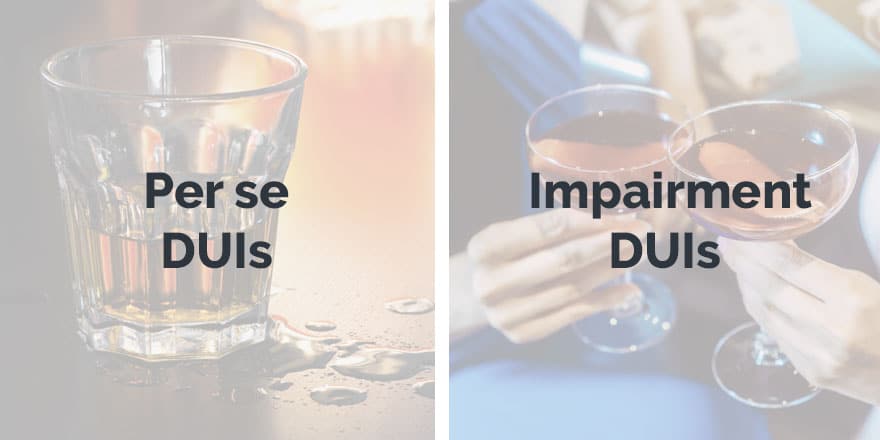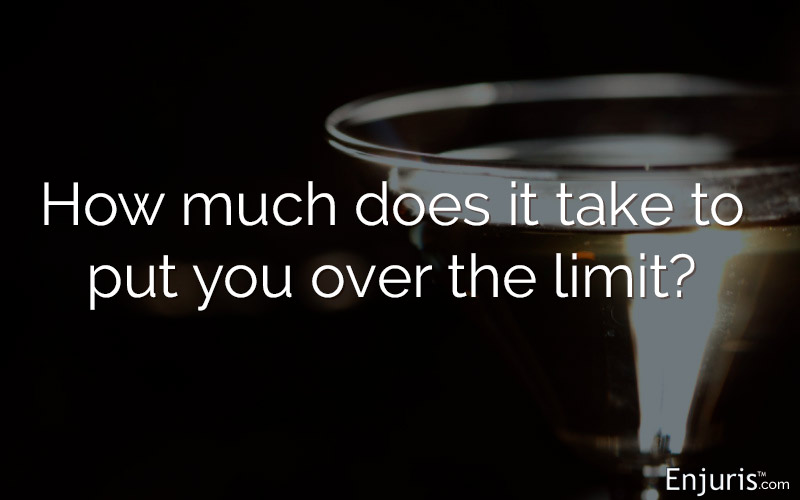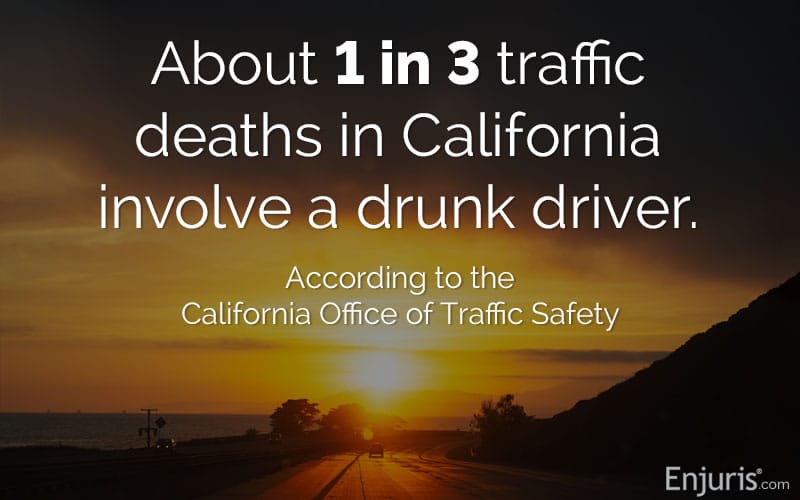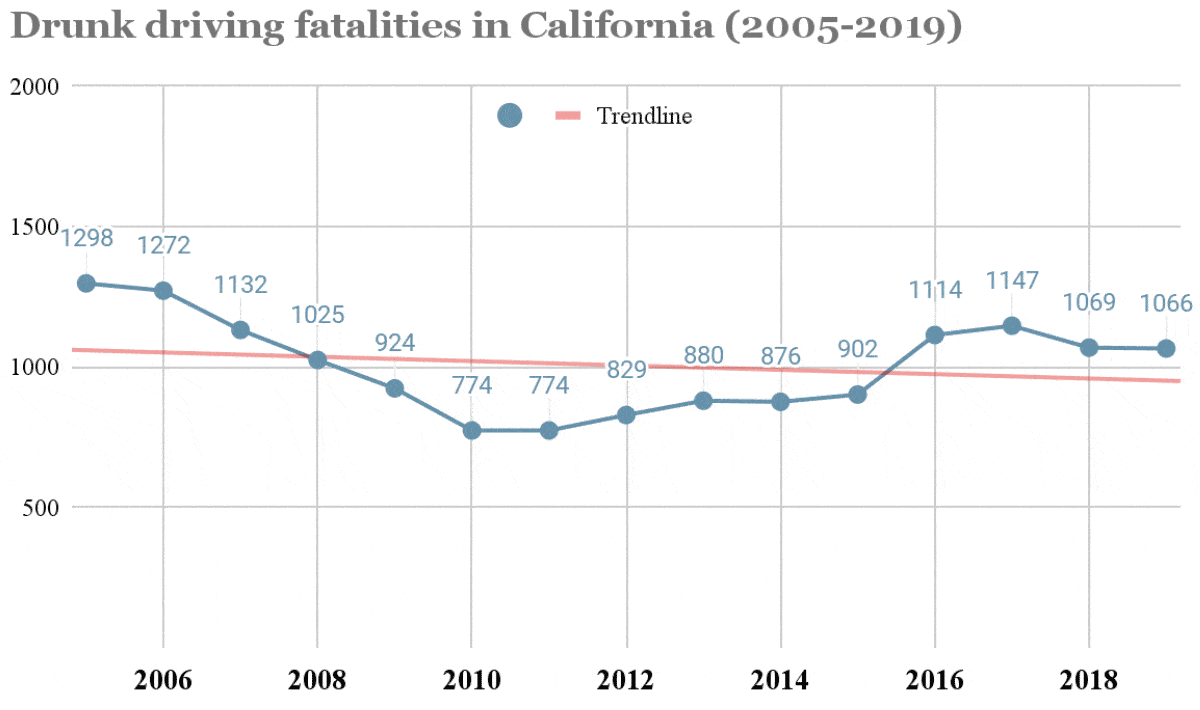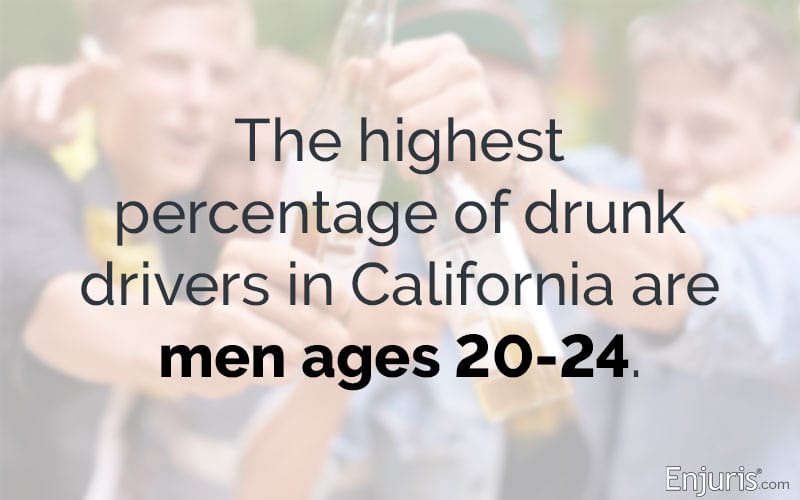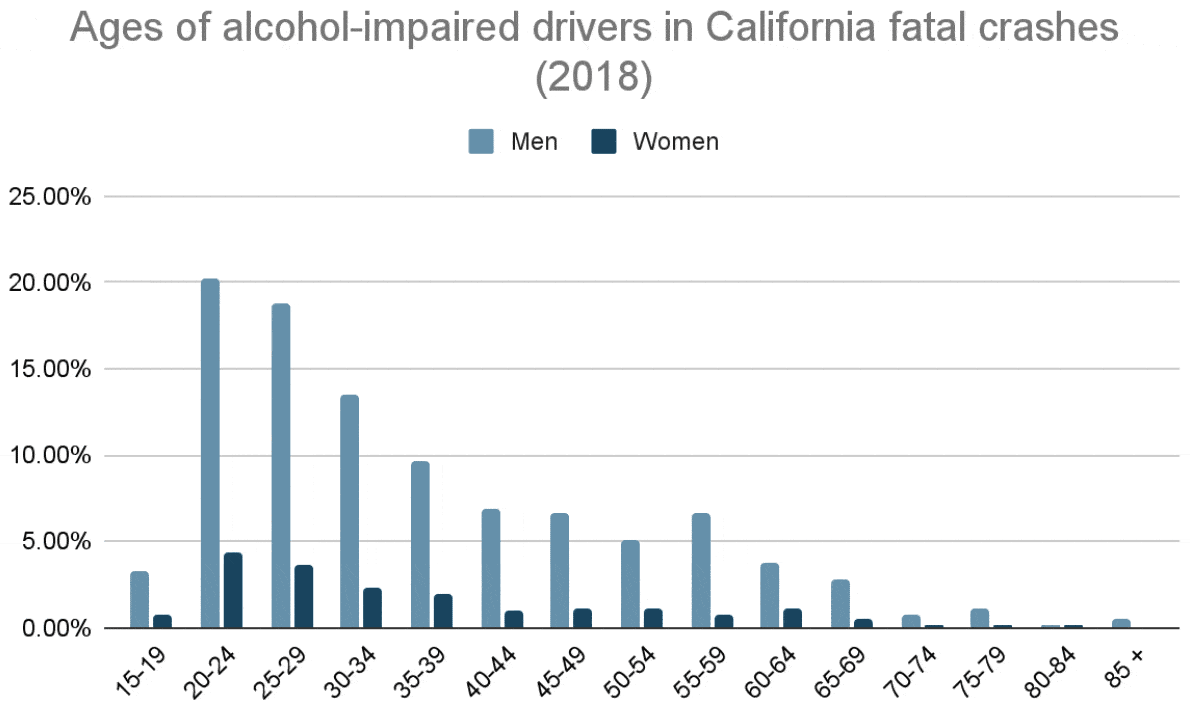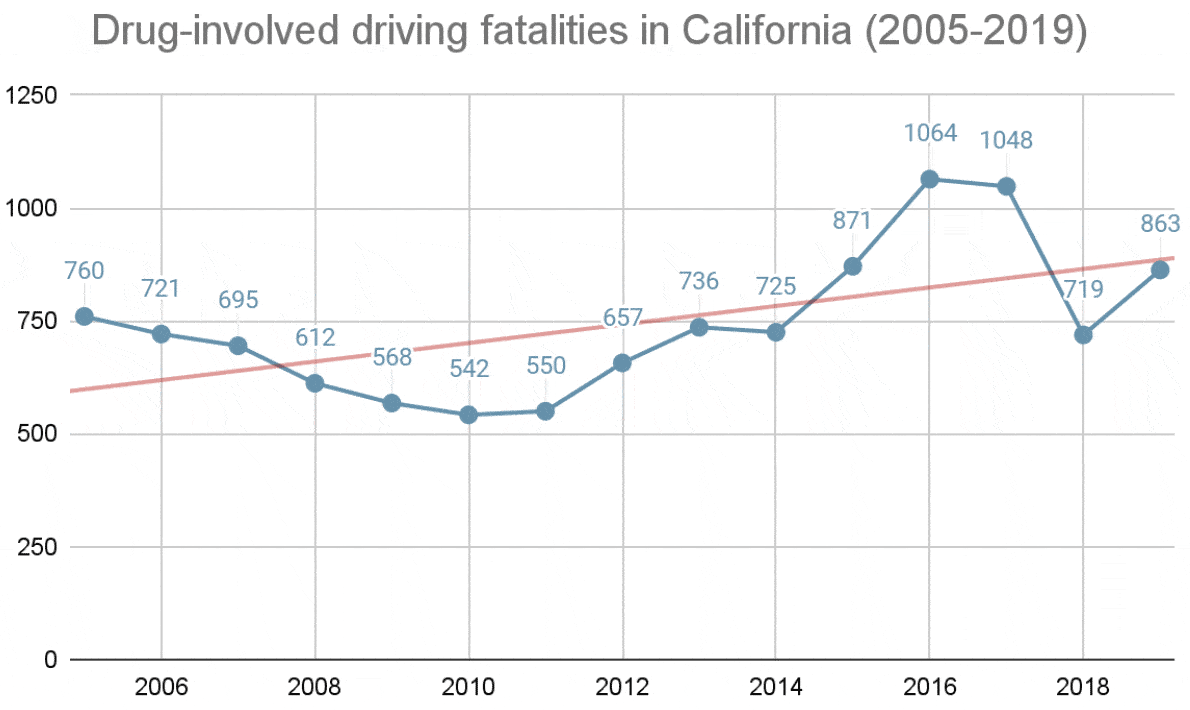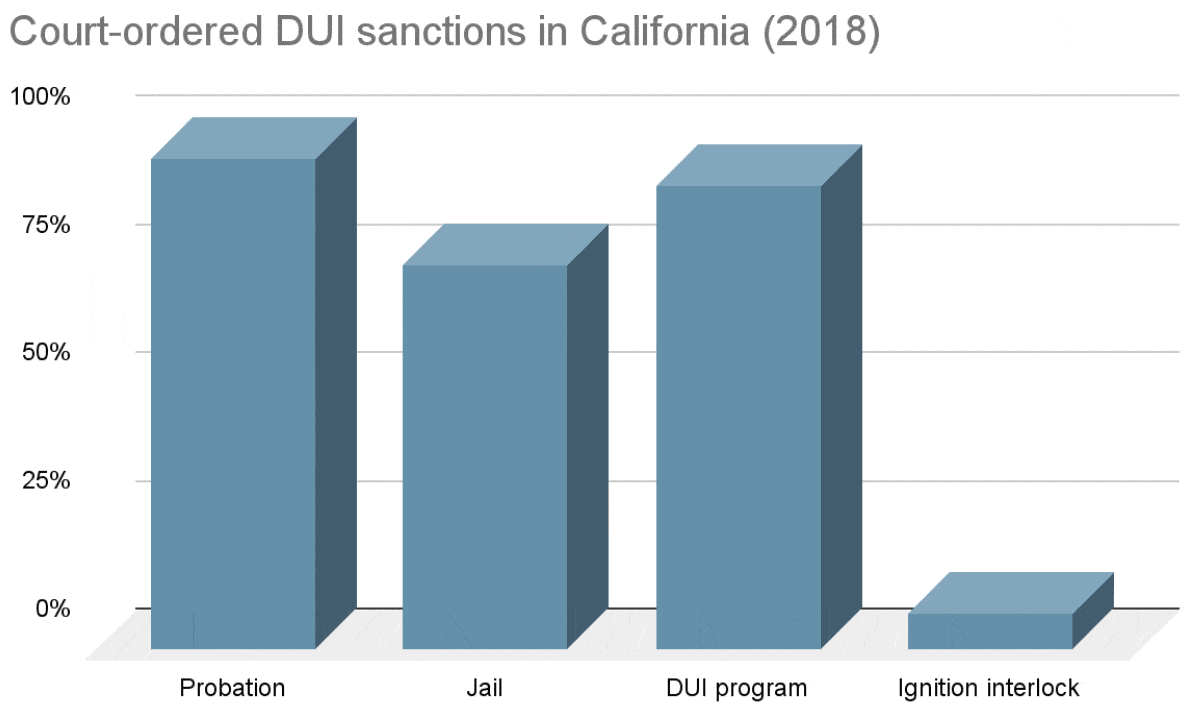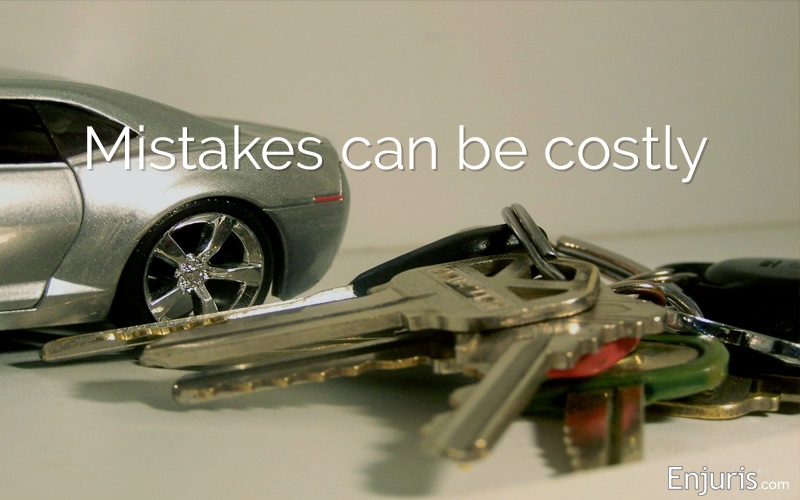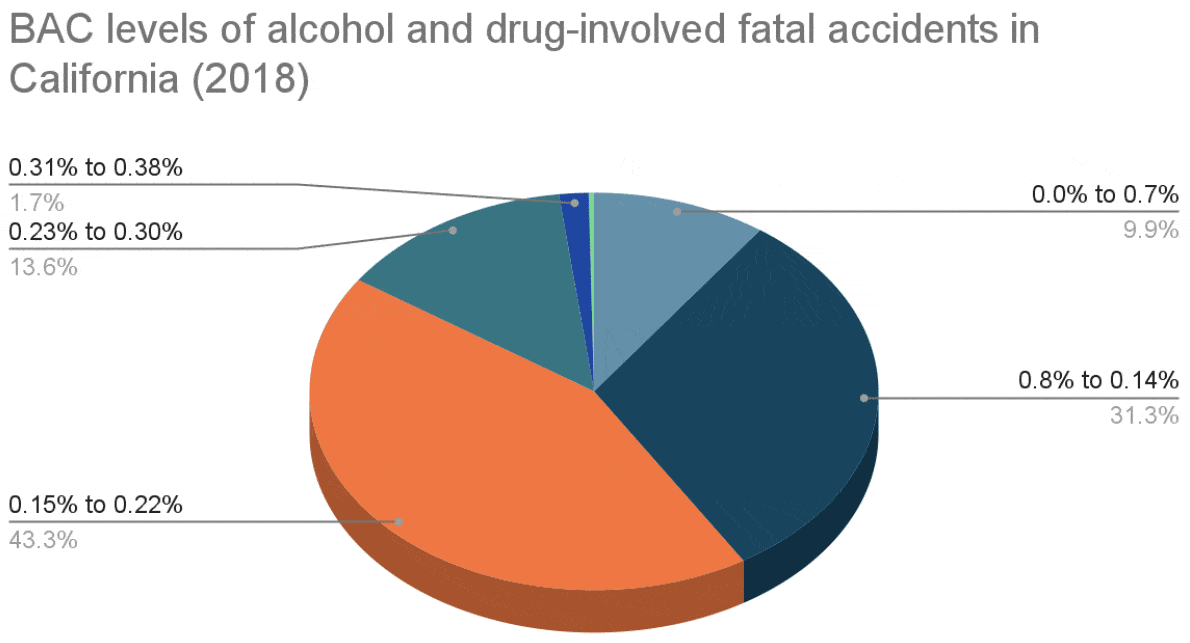DUI is a serious offense, and can cause serious injury or fatality. Here's what to do if you or a loved one are involved in a drunk driving accident.
Almost all of us know someone whose life has been affected by drunk driving.
California has more than 1,000 drunk driving deaths per year, according to recent statistics. In fact, drunk driving makes up 29% of the state's traffic fatalities, and it ranks 25th in the nation for drunk driving fatalities.
Driving under the influence (DUI) isn't just about alcohol. Substances that include both illegal and legal drugs such as prescription or over-the counter-medications or marijuana can all impair your ability to drive safely.
In fact, driving while impaired is a crime. A first offense for driving while impaired in California can involve a fine of up to $10,000.
What constitutes driving under the influence in California?
California's driving under the influence (DUI) laws can be found in the California Vehicle Code.
The laws create two types of DUIs:
Let's take a look at per se DUIs first.
You could be charged with a per se DUI if your blood alcohol content (BAC) is at or over these limits:
California blood alcohol concentration (BAC) limits |
|
|---|---|
| 21 years old or older | 0.08% or higher |
| Less than 21 years old | 0.01% or higher |
| On DUI probation (any age) | 0.01% or higher |
| Driving a commercial vehicle (whether or not the driver has a CDL) | 0.04% or higher |
| When a passenger for hire is in the vehicle (e.g., taxi and Uber drivers) | 0.04% or higher |
Source: The California Vehicle Code
The Latin phrase "per se" means "by itself."
To put it another way, prosecutors don't need to prove that your ability to drive was actually impaired if you have a BAC over the legal limit.
Here's an example of how this could work:
Tom is driving west on Ventura Boulevard when he's pulled over based on a suspicion that he's intoxicated. Tom tells the officer that he just left band practice and is on his way to his home in Reseda. He claims he only had one beer to drink and that he's not intoxicated.
The officer asks Tom to step out of the car and complete three field sobriety tests: the horizontal-gaze-nystagmus test, the walk-and-turn test, and the one-leg-stand test.
Tom passes all three tests with flying colors. For good measure, he volunteers to take a breathalyzer. The breathalyzer reveals that Tom's BAC is 0.08%.
Under California's per se DUI law, Tom can be convicted of a DUI even though he doesn't appear to be impaired.
Now, let's talk about impairment DUIs.
You can be convicted of an impairment DUI if you were under the influence of alcohol or any other drug while operating a motor vehicle, even if you consumed less than the legal limit.
How does a court decide if a driver is "under the influence" of alcohol or drugs?
The California Supreme Court looked at this exact question in People v. Canty (2004):
To be 'under the influence' within the meaning of the Vehicle Code, the [alcohol or drugs] must have so far affected the nervous system, the brain, or muscles as to impair to an appreciable degree the ability to operate a vehicle in a manner like that of an ordinarily prudent and cautious person in full possession of his faculties.
- California Supreme Court
Let's look at an example:
A police officer spots Sheryl driving along Santa Monica Boulevard at dawn. She's driving under the speed limit, but she keeps swerving over the yellow line.
The officer pulls Sheryl over and asks to see her license and registration. Sheryl hesitates and then tells the officer that all she wants to do is have some fun before the sun comes up over Santa Monica Boulevard. The officer spots a torn Budweiser label on the floor of Sheryl's car. Sheryl nervously tells the officer the labels belong to her friend, Billy.
Suspecting that Sheryl might be intoxicated, the officer asks her to perform three field sobriety tests: the horizontal-gaze-nystagmus test, the walk-and-turn test, and the one-leg-stand test.
Sheryl fails all three tests miserably.
The officer gives Sheryl a breathalyzer and her BAC is 0.05% (below the legal limit). Nevertheless, it's clear that Sheryl's ability to operate a vehicle has been impaired by the alcohol she consumed. The officer charges Sheryl with an impairment DUI.
Evidence that may be used to support a decision that a person is "under the influence" of alcohol or drugs may include:
- Erratic driving
- Poor performance on a field sobriety test
- Slurred speech
- Odd behavior
- An admission of being impaired
The effects of blood alcohol concentration (BAC) |
||
|---|---|---|
| BAC | Typical effects | Predictable effects on driving |
| .02 | Some loss of judgment, relaxation, slight body warmth, altered mood | A decline in visual functions (rapid tracking of a moving target) and a decline in the ability to perform 2 tasks at the same time |
| .05 | Exaggerated movement, some loss of small-muscle control (e.g., focusing your eyes), impaired judgment, lowered alertness, the release of inhibition | Reduced coordination, reduced ability to track moving objects, difficulty steering, reduced response to emergency driving situation |
| .08 | Muscle coordination becomes poor (e.g., balance, speech, vision, reaction time, and hearing), harder to detect danger; judgment, self-control, reasoning, and memory are impaired | Concentration, short-term memory loss, speed control, reduced information processing capability (e.g., signal detection, visual search), impaired perception |
| .10 | Clear deterioration of reaction time and control, slurred speech, poor coordination, and slowed thinking | Reduced ability to maintain lane position and brake appropriately |
| .15 | Far less muscle control than normal, vomiting may occur (unless this level is reached slowly or a person has developed a tolerance for alcohol), major loss of balance | Substantial impairment in vehicle control, attention to driving task, and in necessary visual and auditory information processing |
Source: National Highway Traffic Safety Administration
Blood alcohol content and the law
Blood alcohol content (BAC) allows medical professionals to measure alcohol levels in your blood. What's the magic number for intoxication? What if you refuse a Brethalyzer?
Driving while taking over-the-counter medication in California
You probably don't think twice about popping a couple of Advil and getting behind the wheel of your car, but you should. You can be convicted of an impairment DUI based on your consumption of an over-the-counter medication.
Here's what to look out for if you're planning to drive after taking any medication:
- Drugs like cold medicine (decongestants), hay fever or allergy medicines, or medications to calm nerves or muscles can make you drowsy.
- Be aware of how medicine might interact with alcohol or other medications. Some drugs' side effects are heightened when combined with alcohol or other medications.
- "Uppers," diet pills, and energy supplements can increase a driver's alertness. But they can also cause nervousness, dizziness, and a lack of concentration or impaired vision.
- Avoid any drug that says "may cause drowsiness or dizziness" if you intend to drive.
California's implied consent law
California's implied consent law requires anyone who has been lawfully arrested for DUI in California to submit to a breath test to determine their BAC.
A driver who refuses to take a breath test following an arrest will receive the following penalties:
- Increased DUI penalties (fines and possible jail time) if ultimately convicted, and
- A mandatory driver's license revocation for one year regardless of the outcome of the DUI case.
California's implied consent law used to include a DUI blood test, but the United States Supreme Court ruled that defendants cannot be penalized for refusing to take a blood test in cases in which the police have not obtained a warrant.
Because California's implied consent law only applies after a person has been arrested, you can lawfully refuse to take a breath test (or any other field sobriety test) before you're arrested unless you are:
- Under the age of 21, or
- On probation for a prior DUI conviction.
Is it illegal to drive with alcohol (or marijuana) in your vehicle in California?
California law prohibits all drivers from driving with an open container of alcohol or an open receptacle containing cannabis.
In most cases, these offenses are infractions and carry a fine.
If you're under the age of 21:
- You're not allowed to carry liquor, beer, or wine in a vehicle unless accompanied by a parent and the container is full, sealed and unopened.
- Your vehicle can be impounded for up to 30 days if you're in possession of alcohol in the car. You can also be subject to a fine of up to $1,000 and lose driving privileges for up to 1 year. If you're not already licensed, the DMV can delay your driver's license for up to 1 year.
How common is drunk driving in California?
Drunk driving is probably more common than you think. One person dies as a result of drunk driving every 50 minutes in the United States.
Alcohol-impaired driving makes up roughly 30 percent of traffic fatalities in California.
There is some good news, though. Drunk driving fatalities in California have trended downward over the last 15 years.
Women have an undeserved reputation of being worse drivers than men in California, but the people most likely to be involved in a fatal drunk driving accident in California are men ages 20-24.
Unfortunately, while drunk driving fatalities have been declining over the last 15 years, drug-involved traffic fatalities have increased significantly over that same time period.
Total number of DUI/Drug crashes in each California county (2018) |
||
|---|---|---|
| County | Total | |
| Los Angeles | 4,638 | |
| San Diego | 1,601 | |
| Orange | 1,358 | |
| San Bernardino | 1,251 | |
| Riverside | 1,166 | |
| Sacramento | 838 | |
| Alameda | 658 | |
| Santa Clara | 566 | |
| Kern | 451 | |
| San Joaquin | 429 | |
| Ventura | 382 | |
| Stanislaus | 381 | |
| Contra Costa | 371 | |
| Fresno | 338 | |
| San Francisco | 318 | |
| Sonoma | 287 | |
| Solano | 257 | |
| San Mateo | 253 | |
| Santa Barbara | 244 | |
| Tulare | 233 | |
| Monterey | 230 | |
| Merced | 197 | |
| Santa Cruz | 188 | |
| San Luis Obispo | 170 | |
| Humboldt | 152 | |
| El Dorado | 144 | |
| Butte | 136 | |
| Placer | 133 | |
| Shasta | 126 | |
| Marin | 121 | |
| Sutter | 108 | |
| Yolo | 107 | |
| Madera | 105 | |
| Napa | 105 | |
| Nevada | 92 | |
| San Benito | 88 | |
| Mendocino | 77 | |
| Kings | 73 | |
| Lake | 71 | |
| Tuolumne | 64 | |
| Calaveras | 57 | |
| Imperial | 51 | |
| Tehama | 49 | |
| Amador | 43 | |
| Siskiyou | 41 | |
| Glenn | 27 | |
| Inyo | 24 | |
| Mariposa | 24 | |
| Plumas | 21 | |
| Trinity | 20 | |
| Del Norte | 16 | |
| Colusa | 15 | |
| Lassen | 11 | |
| Modoc | 7 | |
| Mono | 1 | |
| Yuba | 1 | |
| Alpine | 0 | |
| Sierra | 0 | |
Penalties for driving under the influence in California
DUIs can be charged as misdemeanors or felonies under California law.
A defendant's first, second or third DUI is typically charged as a misdemeanor. A defendant is typically charged with a felony if they have three prior DUIs in 10 years, have a prior felony DUI, were involved in a drunk driving accident that caused an injury, or there was a minor in the vehicle.
Here's a closer look at the penalties for driving while under the influence of intoxicants in California:
| California misdemeanor DUI penalties | ||||
|---|---|---|---|---|
| Offense | Fines | Jail time | License suspension | Other |
| 1st offense | $390-$1,000 | Up to 6 months | 6 months | 6 months with interlock ignition device (IID) or 1 year of restricted license |
| 2nd offense | $390-$1,000 | 4 days to 1 year | 2 years | 1 year of IID or restricted license |
| 3rd offense | Up to $1,800 | 120 days to 1 year | 3 years | 2 years of IID or restricted license |
| California felony DUI penalties | ||||
|---|---|---|---|---|
| Offense | Fines | Jail time | License suspension | Other |
| 4th offense in 10 years | Up to $5,000 | 16-36 months in state prison | Up to 10 years | Five years of formal probation; habitual traffic offender status for 3 years; addiction treatment; additional court fees |
| Accident results in injury | Up to $5,000 | 16-36 months in state prison and an additional 3-6 years for each person who was seriously injured | Up to 10 years | Five years of formal probation; habitual traffic offender status for 3 years; addiction treatment; additional court fees; restitution to victims |
| Accident results in death | Up to $10,000 | Minimum of 4 years in state prison | Up to 10 years | Five years of formal probation; habitual traffic offender status for 3 years; addiction treatment; additional court fees; restitution to victims |
California DUI arrest and conviction statistics
Although some drunk drivers might make it home without getting into an accident and without getting pulled over, hundreds of thousands of drunk drivers are arrested every year in California.
| California DUI arrest and conviction statistics (2008-2018) | |||||||||||
|---|---|---|---|---|---|---|---|---|---|---|---|
| DUI measures | 2008 | 2009 | 2010 | 2011 | 2012 | 2013 | 2014 | 2015 | 2016 | 2017 | 2018 |
| Arrests | 214,811 | 208,531 | 195,879 | 180,212 | 172,893 | 160,388 | 154,743 | 141,372 | 130,054 | 123,548 | 127,437 |
| Convictions | 169,035 | 161,074 | 148,042 | 142,121 | 133,525 | 121,304 | 116,190 | 106,627 | 98,430 | 93,606 | Not available |
| Conviction rate | 78.7% | 77.2% | 73.1% | 73.3% | 73.7% | 72.5% | 72.7% | 72.6% | 73.6% | 72.9% | Not available |
The most frequent court sanction for all convicted DUI offenders in 2018 was probation (96%), while ignition interlock (7.3%) was the least likely punishment.
Males comprise almost 80% of all DUI arrests in California, but the proportion of females arrested for DUI has been gradually increasing since 1989.
Hispanics have been the largest racial or ethnic group to be arrested for DUI in California over the past decade. Hispanics continue to be arrested at a rate substantially higher than their percentage of California's population.
How much does a drunk driving accident cost?
A DUI can wreak havoc on a victim and their family, but drinking and driving also comes with a high financial cost.
How do I know if I've had too much to drink?
If you're out drinking, the best decision you can make is to call an Uber (or other rideshare service), taxi, or sober friend. Sure, you may not feel drunk, but alcohol affects your judgment! What's more, it's impossible to know for certain how many drinks it takes before you're legally intoxicated.
Many factors can affect your level of intoxication, including:
- Your gender at birth
- Your weight
- Your mood (people who are fatigued or stressed become intoxicated more quickly)
- Your medical condition
- Your tolerance
- How much you've eaten that day
- The time period during which the drinks were consumed
- The amount of carbonation in the drinks you consumed (carbonated alcoholic drinks increase the rate of alcohol absorption)
- The altitude (drinks consumed at high altitudes are almost twice as potent for the first few days until the person becomes accustomed to the elevation)
With all of that in mind, here's a chart to help you estimate your BAC based solely on your weight and the number of drinks you've consumed.
| Approximate blood alcohol percentage | ||||||||
|---|---|---|---|---|---|---|---|---|
| Drinks | 100 lb. | 120 lb. | 140 lb. | 160 lb. | 180 lb. | 200 lb. | 220 lb. | 240 lb. |
| 1 | .04 | .03 | .03 | .02 | .02 | .02 | .02 | .02 |
| 2 | .08 | .06 | .05 | .05 | .04 | .04 | .03 | .03 |
| 3 | .11 | .09 | .08 | .07 | .06 | .06 | .05 | .05 |
| 4 | .15 | .12 | .11 | .09 | .08 | .08 | .07 | .06 |
| 5 | .19 | .16 | .13 | .12 | .11 | .09 | .09 | .08 |
| 6 | .23 | .19 | .16 | .14 | .13 | .11 | .10 | .09 |
| 7 | .26 | .22 | .19 | .16 | .15 | .13 | .12 | .11 |
| 8 | .30 | .25 | .21 | .19 | .17 | .15 | .14 | .13 |
| 9 | .34 | .28 | .24 | .21 | .19 | .17 | .15 | .14 |
Source: State Liquor Control Commission
How to spot a drunk driver
It could be tricky to distinguish a drunk driver from a distracted driver. Either way, your response should be the same: STAY FAR AWAY.
Mothers Against Drunk Driving (MADD) offers these common signs of driving while under the influence to help you spot a drunk driver:
- Quick acceleration or deceleration
- Tailgating
- Weaving or swerving across the road
- Driving anywhere other than on a road designated for vehicles
- Almost striking (or actually striking) an object, curb or vehicle
- Stopping without cause or erratic braking
- Drifting in and out of traffic lanes
- Signaling that is inconsistent with the driver's actions
- Slow response to traffic signals
- Straddling the center lane marker
- Driving with headlights off at night
- Swerving
- Driving slower than 10 mph below the speed limit
- Turning abruptly or illegally
- Driving on the wrong side of the road
The California Highway Patrol encourages citizens to report drunk drivers by calling 9-1-1. You'll be asked to provide your location, along with details about the drunk driver. You should never attempt to apprehend a suspected drunk driver yourself. A person under the influence of drugs or alcohol could be violent, unpredictable or even armed. The police are specifically trained to deal with these types of situations and anticipate behavior.
Recovering damages after a DUI-related accident
If you're injured in a car accident caused by a drunk driver, you can file an insurance claim like you would in any other car accident.
You may need to file a personal injury lawsuit against the intoxicated driver if:
- The intoxicated driver is uninsured and your uninsured motorist coverage won't cover your damages,
- The intoxicated driver's insurance company doesn't offer you enough money to settle, or
- Your damages exceed the intoxicated driver's policy limits.
Keep in mind that in order to recover damages, you'll need to prove that the intoxicated driver caused your accident. You can't recover damages if YOU caused an accident and the other driver involved happened to be intoxicated, for example. In California, there are three types of damages available in drunk driving accidents:
- Economic damages (sometimes called "special damages") are intended to compensate you for the objectively verifiable monetary losses that result from your accident (medical expenses, lost wages, property damage, etc.).
- Non-economic damages (sometimes called "general damages") are intended to compensate you for the subjective, non-monetary losses caused by your injury. Non-economic damages are difficult to prove, but keeping good records can help.
- Punitive damages are intended to punish the defendant. Punitive damages are only available in certain situations.
Case Study: Taylor v. Superior Court (598 P. 2d 854 - Cal: Supreme Court 1979)
In this landmark case, the California Supreme Court extended punitive damages to lawsuits against drunk drivers.
The Court said that an award of punitive damages can be justified under a theory of conscious disregard if the plaintiff proves that the defendant was "aware of the probable dangerous consequences of his conduct, and that he willfully and deliberately failed to avoid" them.
The Court went on to say that consuming alcohol to the point of intoxication, knowing that you're going to operate a motor vehicle, exhibits conscious disregard for the safety of others.
Therefore, a plaintiff can make a claim for punitive damages if:
- The defendant's drunk driving caused the accident, and
- The act of driving while intoxicated was an aggravating circumstance.
In a later case that relied on Taylor, it was decided that an insurance company isn't required to pay punitive damages in a drunk driving case. The defendant's insurance company might be obligated to pay for any compensatory damages, but the defendant would need to pay the punitive damages out of their own pocket.
California dram shop law
California's dram shop law (sometimes called a "social host liability law") can be found in California Civil Code Section 1714.
Here is the money quote:
[T]he furnishing of alcoholic beverages is not the proximate cause of injuries resulting from intoxication, but rather the consumption of alcoholic beverages is the proximate cause of injuries inflicted upon another by an intoxicated person.
In other words, an establishment or social host that provides alcoholic beverages to an intoxicated person in California will NOT—in most cases—be held liable for the damages caused by the intoxicated person.
There are exceptions to California's general rule that establishments and social hosts are not liable for the damages caused by intoxicated patrons.
Here are the exceptions under California law:
- If a parent, guardian, or another adult knowingly serves alcohol to a person under 21 years of age, the adult can be held liable for any damages caused by the underage drinker. Under this law, actual knowledge is not necessary. It's enough to be held liable if the adult should have known the person served alcohol was under the age of 21.
- If an employee of an establishment that's licensed to serve alcohol serves alcohol to an "obviously intoxicated minor," the employee can be held liable.
Steps to take after a drunk driving accident
The aftermath of a drunk driving accident can be extremely chaotic and overwhelming. There are, however, a few simple steps you can take that may improve your chances of recovering the damages you deserve down the road.
Here are the top 5 steps to take after a California drunk driving accident:
- Get medical attention. Your top priority should be your health. Call 9-1-1 if you or anyone else is injured.
- Call the police. It's always a good idea to call the police if you were involved in an accident with a drunk driver. The police can investigate the accident and draft a police report. Be sure to let the responding officer know you suspect the other driver is intoxicated. Your statement (and any evidence you can provide) might help the officer establish the necessary reasonable grounds to arrest the driver and issue a blood or breath test.
- Gather evidence. Witnesses are notoriously difficult to track down in the days or weeks following a crash. If there are witnesses nearby (don't forget about people who might have seen the accident from a nearby building), collect their contact information as soon as possible. It's a good idea to get two types of contact information (e.g., phone number and email address), just in case something changes.
It's also a good idea to take photographs of the accident scene and your damages, including anything that might support your claim that the other driver was intoxicated. - Attend all medical follow-up appointments. Plaintiffs in California are required to mitigate their damages. If you fail to attend the follow-up appointments requested by your doctor, the defense may use your failure as an excuse to reduce your damages.
- Meet with an experienced California personal injury attorney. An experienced California personal injury attorney can help you deal with the insurance companies and handle a civil lawsuit if necessary. Most initial consultations are free.
- Bonus step! Stay off social media. Although it may seem harmless, social media posts about your accident (or even your activities following your accident) can be used against you.
Finding a California car accident lawyer after a drunk driving accident
According to the California State Bar, there are more than 190,000 licensed attorneys actively practicing law in the Golden State.
Finding an experienced personal injury attorney can be overwhelming. What's more, you don't want to find just any attorney; you want to find the right attorney.
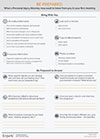
A worksheet to prepare for your first meeting with a personal injury attorney – what to bring, what they'll ask
Download in PDF format
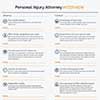
Worksheet with questions to ask a personal injury attorney to help determine if he or she will be a good fit for your case
Download in PDF format
See our guide Choosing a personal injury attorney.


